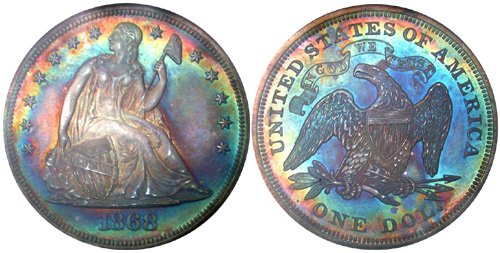Seated Liberty Dollar
Source: My Coin Guides: The silver dollar is considered by many to be the cornerstone of the American monetary system. Introduced in 1794, issues for the denomination range from rare to easily attainable. In the case of the Seated Liberty Dollar, produced from 1840 until 1873, many issues fall into the former category. The coins were struck in limited quantities, heavily exported, and later melted, making the number of overall surviving specimens limited. Additionally, many of the survivors show one or multiple problems, such as cleaning, damage, or tooling. Simply stated, assembling a full collection is extremely difficult, especially when considering that only two uncirculated examples of the key date 1870-S are known to exist.

The design of the Seated Liberty Dollar is derived from the Gobrecht Dollars first struck in 1836. These coins were named for their designer, Christian Gobrecht, a German immigrant responsible for the designs of many of the gold and silver coins that circulated in the 19th century. The Gobrecht Dollars were technically patterns, although a small number were released directly into circulation. Besides this, no other silver dollars had been produced for circulation since 1804, and many of the early dollars had been exported or otherwise held by banks for their bullion value.
The obverse of the new silver dollar was based on the concept of Britannia, who appeared on British coinage. Artist Thomas Sully made a number of sketches from which assistant engraver Christian Gobrecht executed the designs. The female figure of Liberty is seated on a rock, holding a pole in her hand with a Phrygian cap atop. Her right hand rests on a shield with the inscription LIBERTY. The date is placed below the seated figure, thirteen stars are around, and no further lettering is noted.
The reverse of the Seated Liberty Dollar was somewhat based on an earlier design by John Reich, which had been used on the smaller silver denominations during the 19th century. A bald eagle appears facing to the left, with an olive branch and arrows in its talons. The inscription UNITED STATES OF AMERICA is above the eagle, and the denomination expressed as ONE DOL. appears below. Following the American Civil War, the motto IN GOD WE TRUST was added on a scroll above the eagle. The same addition had been made to the quarter and half dollar in the same year.
In 1853, to prevent massive hoarding of silver coinage, a new Mint Act was signed into law, reducing the weight of all silver coins except the silver dollar. With no change made to the largest silver denomination, the intrinsic value became higher than the face value. Silver dollars ceased to circulate in America, with the exception of some areas in the west where circulating money was scarce and paper money was not trusted. The denomination came to be used most frequently for export trade, a situation which persisted until the end of the series in 1873.
